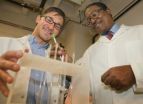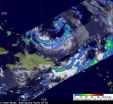(Press-News.org) London, UK (October, 07, 2010) –Many scientists aspire to take control over the stem cell differentiation process, so that we can grow organs and implants perfectly matched to each patient in the future. Now research in the Journal of Tissue Engineering, published by SAGE-Hindawi, explains how engineering the topography on which stem cells grow, and the mechanical forces working on them, can be as powerful an agent for change as their chemical environment.
Stem cells respond to the stiffness, chemistry and topography of the environments they find themselves in – and scientists building their understanding of the complex signalling controlling these responses hope to harness this knowledge to take stem cell research further. As well as increasing the potential to guide stem cells to create desired materials for research and clinical applications, using nanoscale topographies could eliminate (or alternatively enhance) steps including those involving feeder layers and synthetic induction supplements currently used in stem cell culture. In addition, tomorrow's increasingly sophisticated prosthetics for regenerative medicine could feature surfaces with varied tissue zones for different purposes, thanks to this improved understanding.
In their article, Laura McNamara of the University of Glasgow, UK, Centre for Cell Engineering, together with colleagues from Columbia University, New York, Nanotechnology Centre for Mechanics in Regenerative Medicine and the Bone and Joint Research Group at the University of Southampton, UK, review the latest developments in the use of nanotopography to direct stem cell differentiation. In particular they look at skeletal (mesenchymal) stem cells.
Evidence is mounting that researchers can both maintain stem cells in the undifferentiated state, and determine the direction of their fate, by precise control of the surface features beneath them. Stem cells have an uncanny ability to detect and respond to nanoscale grooves, pits and ridges, and are particularly sensitive to the spacing and regularity of these features.
Nanotopographical responsiveness has been observed in diverse cell types including fibroblasts, osteoblasts, osteoclasts, endothelial, smooth muscle, epithelial, and epitenon cells. "This is intriguing from a biomaterials perspective," says McNamara, "as it demonstrates that surface features of just a few nanometres can influence how cells will respond to, and form tissue on, materials."
Stem cells detect surface features with a variety of mechanosensors, including integrin-linked focal adhesions. These respond to the mechanical constraints of the surface by inducing signalling cascades, such as the ERK-MAPK pathway. When the cell's rearranging cytoskeleton physically pulls on components of the cell's nucleus, this force works together with chemical signalling. Together these indirect (biochemical signal-mediated) and direct (force-mediated) factors can modulate nuclear components, altering gene expression to direct stem cell responses.
One interesting finding has been that topography can in some cases have the same effect as biochemical differentiation factors. The potential to eliminate the need for the latter opens the door to development of improved clinical prostheses with topographies that can directly modulate stem cell fate. In particular, the authors envisage applications involving engineered topography components for stem cells in regenerative medicine, for instance, in orthopaedics and dental implants. A combination of different topographies could be used to differentially functionalise implants for distinct applications, or demarcate particular "zones" within a single device.
Orthopaedic implants designed with specific regions tailored to integrate with bone and improve the chances of implant fixation might be seamlessly join other areas of the implant programmed to reduce excessive bony ingrowth, for example. Some surfaces with clinical potential include nanostructured titanium and diamond. A growing number of precision nanofabrication techniques are becoming available to help carve out the substrates needed for this research.
Skeletal stem cells have even been shown to grow into non-skeletal cells (known as transdifferentiation) on surfaces with the right groves and ridges – in some studies this has produced neural tissue.
"With the emergence of mechanical stimuli as critical modulators of cellular functionality, nanotopography should prove an excellent tool for development of novel biomaterials capable of promoting desirable cellular behaviour, discouraging unwanted cell responses, and preventing or ameliorating pathological changes," the authors suggest.
###
Nanotopographical Control of Stem Cell Differentiation by Laura E. McNamara, Rebecca J. McMurray, Manus J. P. Biggs, Fahsai Kantawong, Richard O. C. Oreffo, and Matthew J. Dalby is published in the Journal of Tissue Engineering.
The article is available free here: http://www.sage-hindawi.com/journals/jte/2010/120623.html
Author contact: Laura McNamara - Laura.McNamara@glasgow.ac.uk
SAGE-Hindawi Access to Research is a partnership between SAGE Publications and Hindawi Publishing Corporation to jointly publish a collection of open access journals on a variety of subjects in science, technology, and medicine.
SAGE is a leading international publisher of journals, books, and electronic media for academic, educational, and professional markets. Since 1965, SAGE has helped inform and educate a global community of scholars, practitioners, researchers, and students spanning a wide range of subject areas including business, humanities, social sciences, and science, technology and medicine. An independent company, SAGE has principal offices in Los Angeles, London, New Delhi, Singapore and Washington DC www.sagepublications.com
Hindawi Publishing Corporation is a rapidly growing open access publisher, with offices in Cairo, Egypt. Hindawi currently publishes more than 100 fully Open Access journals covering a wide range of subjects in Science, Technology, and Medicine. http://www.hindawi.com
WASHINGTON, DC-In the weeks leading up to the 2010 midterm elections, five forecasters or teams of forecasters offer models and predictions for the House in the most recent issue (October 2010) of PS: Political Science and Politics, a journal of the American Political Science Association. The models offer a broad consensus that the Republicans will make substantial gains in the House, although there is not a consensus over how large those gains will be. A 30-seat spread between the low and high end of the seat change forecast range exists, with two forecasters giving an ...
A team of researchers from North Carolina State University and the U.K. has found that the low rate of energy conversion in all-polymer solar-cell technology is caused by the structure of the solar cells themselves. They hope that their findings will lead to the creation of more efficient solar cells.
Polymeric solar cells are made of thin layers of interpenetrating structures from two different conducting plastics and are increasingly popular because they are both potentially cheaper to make than those currently in use and can be "painted" or printed onto a variety ...
STANFORD, Calif. — A genetic marker touted as a predictor of coronary artery disease is no such thing, according to a study led by researchers at the Stanford University School of Medicine.
The massive international study, published online Oct. 7 in the Journal of the American College of Cardiology, assessed the predictive value of a leading genetic assay for risk of atherosclerosis.
The study analyzed the data from more than 17,000 patients with cardiovascular disease and 40,000 others to assess whether carrying a particular variant of the KIF6 gene indicated a greater ...
Researchers at the Institute for Genomic Biology at the University of Illinois have developed a way to harness the prodigious quantities of both genomic and metabolic data being generated with high-throughput genomics and other techniques. They have developed an algorithm that automatically integrates both data sets. The model, called probabilistic regulation of metabolism (PROM), enables researchers to perturb a given regulatory gene or metabolic process and see how that affects the entire network.
"PROM provides a platform for studying the behavior of networks in a ...
Does thinking about time or money make you happier? A new study published in Psychological Science, a journal of the Association for Psychological Science, finds that people who are made to think about time plan to spend more of their time with the people in their lives while people who think about money fill their schedules with work, work, and—you guessed it—more work.
To find out how thinking about time or money makes people feel, Cassie Mogilner of the University of Pennsylvania designed an experiment, carried out online with adults from all over the United States, ...
PROVIDENCE, R.I. [Brown University] — As the United States seeks to lessen its reliance on foreign oil, biodiesel is expected to play a role. According to the National Renewable Energy Laboratory, a branch of the Department of Energy, biodiesel "represents a significant energy resource and could someday supply 3 percent to 5 percent of the distillate fuel market."
One major obstacle to achieving that goal is figuring how to efficiently convert the abundant stocks of waste vegetable oil (oil used after cooking French fries, for example) into biodiesel fuel. Current techniques ...
The way melanoma cells use the immune system to spread and develop into lung tumors may lead to a therapy to decrease development of these tumors, according to Penn State researchers.
"Melanoma is the most aggressive and metastatic form of skin cancer," said Gavin Robertson, professor of pharmacology, pathology, dermatology and surgery in the Penn State College of Medicine. "Therefore, identifying proteins and molecular mechanisms that regulate metastasis is important for developing drugs to treat this disease."
Metastasis is a complex process in which cancer cells ...
CAMBRIDGE, Mass. -- By creating a better way to see molecules at work in living brain cells, researchers affiliated with MIT's Picower Institute for Learning and Memory and the MIT Department of Chemistry are helping elucidate molecular mechanisms of synapse formation. These studies could also help further understanding of how synapses go awry in developmental diseases such as autism and Fragile X syndrome. The study will appear in the Oct. 7 issue of Cell.
Using the new technique, which is more accurate and sensitive than existing methods, the researchers found that ...
WASHINGTON—October 7, 2010—The U.S. invested $139 billion last year in health research from all public and private sources, according to Research!America's latest annual estimate. That amount represents only 5.6% of the $2.47 trillion overall U.S. health spending in 2009—or 5.6¢ of every health dollar—which varies no more than 0.2% from 2005 levels.
The estimate is available here: http://www.researchamerica.org/uploads/healthdollar09.pdf.
The 2009 investment grew by only 0.1% over 2008. This small increase can be attributed largely to the federal stimulus funding ...
NASA satellites have collected data as the Atlantic Ocean's Tropical Depression 17 has undergone two changes in less than 24 hours. Since Oct. 6, the depression has strengthened and has tropical storm-force winds and has morphed from a sub-tropical storm into a tropical storm.
After a United States Air Force Reserve reconnaissance flight subtropical depression seventeen was upgraded by the National Hurricane Center (NHC) to subtropical storm Otto on Oct. 6 at 5 p.m. EDT (2100 UTC). On Oct. 6 and 7, NASA's TRMM and Aqua satellites were flying overhead measuring very cold, ...


